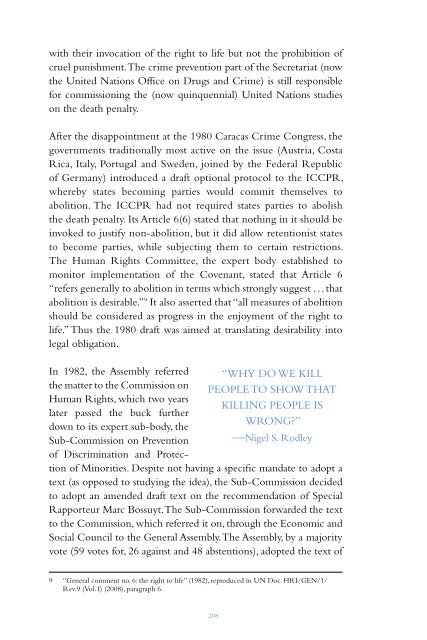PENALTY
DBk0302s7Xm
DBk0302s7Xm
Create successful ePaper yourself
Turn your PDF publications into a flip-book with our unique Google optimized e-Paper software.
with their invocation of the right to life but not the prohibition of<br />
cruel punishment. The crime prevention part of the Secretariat (now<br />
the United Nations Office on Drugs and Crime) is still responsible<br />
for commissioning the (now quinquennial) United Nations studies<br />
on the death penalty.<br />
After the disappointment at the 1980 Caracas Crime Congress, the<br />
governments traditionally most active on the issue (Austria, Costa<br />
Rica, Italy, Portugal and Sweden, joined by the Federal Republic<br />
of Germany) introduced a draft optional protocol to the ICCPR,<br />
whereby states becoming parties would commit themselves to<br />
abolition. The ICCPR had not required states parties to abolish<br />
the death penalty. Its Article 6(6) stated that nothing in it should be<br />
invoked to justify non-abolition, but it did allow retentionist states<br />
to become parties, while subjecting them to certain restrictions.<br />
The Human Rights Committee, the expert body established to<br />
monitor implementation of the Covenant, stated that Article 6<br />
“refers generally to abolition in terms which strongly suggest . . . that<br />
abolition is desirable.” 9 It also asserted that “all measures of abolition<br />
should be considered as progress in the enjoyment of the right to<br />
life.” Thus the 1980 draft was aimed at translating desirability into<br />
legal obligation.<br />
“WHY DO WE KILL<br />
PEOPLE TO SHOW THAT<br />
KILLING PEOPLE IS<br />
WRONG?”<br />
—Nigel S. Rodley<br />
In 1982, the Assembly referred<br />
the matter to the Commission on<br />
Human Rights, which two years<br />
later passed the buck further<br />
down to its expert sub-body, the<br />
Sub-Commission on Prevention<br />
of Discrimination and Protection<br />
of Minorities. Despite not having a specific mandate to adopt a<br />
text (as opposed to studying the idea), the Sub-Commission decided<br />
to adopt an amended draft text on the recommendation of Special<br />
Rapporteur Marc Bossuyt. The Sub-Commission forwarded the text<br />
to the Commission, which referred it on, through the Economic and<br />
Social Council to the General Assembly. The Assembly, by a majority<br />
vote (59 votes for, 26 against and 48 abstentions), adopted the text of<br />
9 “General comment no. 6: the right to life” (1982), reproduced in UN Doc. HRI/GEN/1/<br />
Rev.9 (Vol. I) (2008), paragraph 6.<br />
what is now the Second Optional Protocol [to the ICCPR] Aiming<br />
at the Abolition of the Death Penalty.<br />
The preamble to the Protocol refers to the right to life in language<br />
borrowed from the Human Rights Committee’s general comment on<br />
ICCPR Article 6; it also directly cites UDHR Article 3 and ICCPR<br />
Article 6. It does not explicitly invoke the prohibition of cruel punishment,<br />
though it expresses the belief that abolition “contributes to<br />
the enhancement of human rights and progressive development of<br />
human rights.” Presumably, the drafters preferred to avoid the use<br />
of language like “cruel, inhuman or degrading” to characterize the<br />
penal practices of states that may not yet be ready to ratify but would<br />
be willing to abstain from voting on adoption of the text, as long as<br />
they did not feel insulted. Meanwhile, by 1994, the Human Rights<br />
Committee was making clear that, had Article 6 of the ICCPR not<br />
provided for retention, Article 7’s prohibition of cruel punishments<br />
would have been applicable. 10<br />
Also in 1994, Italy tried unsuccessfully to get another weak abolitionist<br />
resolution through the General Assembly. 11 In 1997, Italy<br />
decided to centre its efforts on the United Nations Commission<br />
on Human Rights, where it successfully proposed a stronger text.<br />
This repeated the earlier General Assembly call for the progressive<br />
restriction of capitally punishable offences and establishment of a<br />
moratorium “with a view to completely abolishing the death penalty.”<br />
12 After a number of resolutions reiterating this language, by<br />
2003 the Commission was able to make the stronger direct call, in<br />
its Resolution 2003/67, “to abolish the death penalty completely<br />
and, in the meantime, to establish a moratorium on executions.”<br />
It repeated the approach in its final substantive session in 2005<br />
(Resolution 2005/59). Like earlier initiatives, it referred to UDHR<br />
Article 3 and ICCPR Article 6.<br />
10 Ng v. Canada, UN Doc. CCPR/C/49/D/469/1991 (1994), paragraph 16.2; see William A.<br />
Schabas, The Death Penalty as Cruel Treatment and Torture (Boston, Northeastern University Press,<br />
1996).<br />
11 States would merely have been invited to “consider” progressive restriction of the number of<br />
capitally punishable offences and the “opportunity” of instituting a moratorium, albeit with the<br />
ambitious goal of abolition by the year 2000; UN Doc. A/C.3/49/L.32 (1994).<br />
12 Commission on Human Rights Resolution 1997/12—27 for, 11 against and 14 abstentions;<br />
see Nigel S. Rodley and Matt Pollard, The Treatment of Prisoners under International Law, 286-287.<br />
208 209


